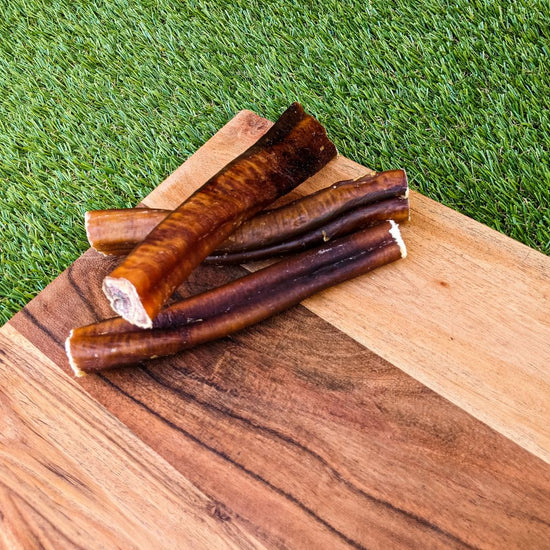
The Ultimate Guide to Dog Foods: Nutrition, Types, and the Role of Bully Sticks

Choosing the right food for your dog is essential for their overall health, well-being, and longevity. A balanced diet provides the necessary nutrients, supports growth and development, and prevents various health issues. This comprehensive guide covers everything you need to know about dog foods, including nutritional needs, different types of dog food, and the benefits of incorporating bully sticks into your dog's diet. Designed to be SEO-friendly, this guide aims to provide valuable information to dog owners looking for the best dietary options for their pets.
Section 1: Understanding Your Dog’s Nutritional Needs
1. Essential Nutrients: Dogs require a variety of essential nutrients to maintain their health. These include:
- Proteins: Essential for growth, muscle repair, and overall health. Good sources include meat, fish, eggs, and legumes.
- Fats: Provide energy and support healthy skin and coat. Include sources like fish oil, chicken fat, and flaxseed.
- Carbohydrates: Supply energy and support digestive health. Sources include grains, vegetables, and fruits.
- Vitamins and Minerals: Vital for metabolic functions, immune health, and bone strength. Ensure your dog’s diet includes a variety of foods to cover these nutrients.
- Water: Essential for all bodily functions. Ensure your dog always has access to fresh water.
2. Life Stage Considerations: Nutritional needs vary depending on your dog’s life stage:
- Puppies: Require more protein and fat to support rapid growth and development.
- Adult Dogs: Need a balanced diet to maintain health and energy levels.
- Senior Dogs: May require fewer calories but higher fiber content to support digestion and prevent obesity.
3. Special Dietary Needs: Some dogs have special dietary requirements due to health conditions:
- Allergies: If your dog has food allergies, opt for hypoallergenic diets with novel protein sources like duck or venison.
- Weight Management: Choose low-calorie, high-fiber foods for weight control.
- Joint Health: Foods with added glucosamine and chondroitin support joint health in older dogs.
Section 2: Types of Dog Food
1. Dry Kibble: Dry kibble is one of the most popular types of dog food due to its convenience and long shelf life. It is also beneficial for dental health as the crunchiness helps reduce plaque and tartar buildup.
- Advantages: Easy to store, cost-effective, and available in various formulations to meet specific dietary needs.
- Considerations: Ensure it contains high-quality ingredients and no artificial additives.
2. Wet Food: Wet food, or canned food, has a higher moisture content, which can be beneficial for hydration and can be more palatable for picky eaters.
- Advantages: Higher moisture content, which helps with hydration; generally more palatable for dogs.
- Considerations: Can be more expensive and has a shorter shelf life once opened. Look for products with natural ingredients and no artificial preservatives.
3. Raw Diet: A raw diet, often referred to as BARF (Biologically Appropriate Raw Food), includes raw meat, bones, fruits, and vegetables. This diet aims to mimic what dogs would eat in the wild.
- Advantages: Can improve coat condition, energy levels, and dental health.
- Considerations: Requires careful handling to avoid bacterial contamination. Consult with a veterinarian to ensure it meets all nutritional needs.
4. Homemade Diet: Preparing homemade meals for your dog allows you to control the ingredients and ensure freshness. However, it requires careful planning to ensure a balanced diet.
- Advantages: Complete control over ingredients, can be tailored to specific health needs.
- Considerations: Time-consuming and requires knowledge of canine nutrition. Consult with a veterinary nutritionist to create balanced recipes.
5. Dehydrated and Freeze-Dried Foods: These types of foods involve removing moisture from fresh ingredients, preserving their nutritional content. They need to be rehydrated before feeding.
- Advantages: Long shelf life, retains nutritional value, and often more palatable than dry kibble.
- Considerations: Can be expensive, and rehydration adds an extra step to feeding.
Section 3: The Role of Bully Sticks in Your Dog’s Diet
1. What Are Bully Sticks? Bully sticks are natural, single-ingredient dog treats made from the pizzle (penis) of a bull or steer. They are high in protein and low in fat, making them a healthy and nutritious treat option.
- Natural and Digestible: Bully sticks are made from 100% beef, making them easily digestible and a natural source of protein.
- Dental Benefits: Chewing on bully sticks helps reduce plaque and tartar buildup, promoting better dental health.
- Long-Lasting: These treats are long-lasting, providing your dog with a satisfying chewing experience that can keep them occupied and mentally stimulated.
2. Nutritional Benefits of Bully Sticks:
- High Protein Content: Bully sticks provide a substantial amount of protein, which is essential for muscle maintenance and energy.
- Low Fat: They are lower in fat compared to many other treats, making them suitable for dogs that need to manage their weight.
- Essential Amino Acids: They contain essential amino acids that support various bodily functions, including muscle repair and immune system support.
3. Choosing the Right Bully Sticks:
- Source and Quality: Opt for bully sticks made from grass-fed, free-range cattle. Ensure they are free from artificial preservatives, chemicals, and hormones.
- Size and Shape: Choose bully sticks that are appropriate for your dog’s size and chewing habits. Thicker sticks are better for aggressive chewers, while thinner sticks may be suitable for smaller dogs.
- Odor-Free Options: Some bully sticks are treated to reduce odor, which can be more pleasant for indoor use.
4. Incorporating Bully Sticks into Your Dog’s Diet:
- Moderation: While bully sticks are healthy, they should be given in moderation as part of a balanced diet. Overfeeding can lead to excessive calorie intake.
- Supervision: Always supervise your dog while they are chewing on bully sticks to prevent choking or swallowing large pieces.
- Hydration: Ensure your dog has access to fresh water while enjoying their bully stick to stay hydrated.
Section 4: Practical Tips for Feeding Your Dog
1. Establish a Feeding Schedule: Consistency is key. Establish a regular feeding schedule to help regulate your dog’s digestion and metabolism. Most adult dogs do well with two meals per day, while puppies may need three to four smaller meals.
2. Portion Control: Overfeeding can lead to obesity, which is linked to various health issues. Measure your dog’s food portions accurately and adjust based on their activity level and body condition.
3. Monitor Weight and Health: Regularly monitor your dog’s weight and overall health. Consult your veterinarian for regular check-ups and to discuss any dietary adjustments needed based on their health status.
4. Transitioning Foods: When switching your dog’s food, do so gradually over a week to prevent digestive upset. Mix increasing amounts of the new food with decreasing amounts of the old food.
5. Avoid Harmful Foods: Certain foods can be toxic to dogs, including chocolate, grapes, onions, garlic, and xylitol (a sugar substitute). Ensure these foods are kept out of reach and never fed to your dog.
Conclusion
Providing your dog with a balanced and nutritious diet is essential for their overall health and well-being. Understanding their nutritional needs, choosing the right type of food, and incorporating healthy treats like bully sticks can significantly enhance their quality of life. Remember, regular veterinary consultations and monitoring your dog’s health are crucial in maintaining their dietary health. With the right diet and care, your dog can enjoy a long, happy, and healthy life.
FAQs:
Q: How do I know if my dog’s food is nutritious? A: Look for high-quality ingredients, a balanced nutrient profile, and an AAFCO statement indicating the food meets nutritional standards.
Q: Can I feed my dog a vegetarian diet? A: While dogs are omnivores, a vegetarian diet can be challenging to balance. Consult a veterinary nutritionist to ensure it meets all nutritional needs.
Q: How often should I change my dog’s food? A: Gradual transitions are best when changing your dog’s food. Introduce new food slowly over a week to prevent digestive upset.
For more detailed information and resources, you can visit AKC, ASPCA, and Dog Nutrition.






